 You may have noticed when you visit one of our “natural areas” that some the signs denote them as a “preserve.” What is the difference? Why do we call the DeYoung Natural Area a natural area and Swanson Preserve a preserve? The name we give to the properties we own or manage can give you a clue to the nature of these places and how the Leelanau Conservancy views them from a management standpoint. In general, Preserves are ecological powerhouses, with little to no human disturbance. Natural Areas, on the other hand, have generally been disturbed or farmed and are generally less fragile environments.
You may have noticed when you visit one of our “natural areas” that some the signs denote them as a “preserve.” What is the difference? Why do we call the DeYoung Natural Area a natural area and Swanson Preserve a preserve? The name we give to the properties we own or manage can give you a clue to the nature of these places and how the Leelanau Conservancy views them from a management standpoint. In general, Preserves are ecological powerhouses, with little to no human disturbance. Natural Areas, on the other hand, have generally been disturbed or farmed and are generally less fragile environments.
What is a Leelanau Conservancy Preserve?
 There are nine properties classified as Preserves: Belanger Creek, Cedar River, Frazier-Freeland, Gull Island, Hatlem Creek, Jeff Lamont, Mebert Creek-Greeno, Swanson, and Teichner. Some of them are more accessible than others (see end of article for best way to explore.)
There are nine properties classified as Preserves: Belanger Creek, Cedar River, Frazier-Freeland, Gull Island, Hatlem Creek, Jeff Lamont, Mebert Creek-Greeno, Swanson, and Teichner. Some of them are more accessible than others (see end of article for best way to explore.)
Preserves are primarily managed for biological diversity and ecological integrity. Limited public use is permitted for educational, scientific and demonstrative purpose. The focus is on restoring the preserves to functioning native ecological communities and/or protecting them. Example: at Teichner Preserve, a road that had been put in was removed, and the wetlands restored/reconnected. Each Preserve (as well as each natural area) has a management plan which is driven by an inventory of its unique natural and cultural features. Preserves vary in size from the vast 440 acres of the Cedar River to the very special seven acres of Gull Island.
How do we know our Preserves are special?
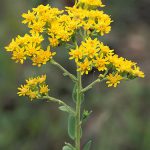 When a property is acquired, we work to understand its effect on water quality and its importance to wildlife. Water quality is monitored annually by staff and trained volunteers. Data has been collected on some streams/lakes for over 20 years. Identification of flyways, wildlife corridors and habitats are done by staff with assistance from experts. We use a tool called the Floristic Quality Assessment (FQA) to understand the conservation value of the plant community on the preserves. The details of the FQA assessments are available on our website under the Natural Areas section.
When a property is acquired, we work to understand its effect on water quality and its importance to wildlife. Water quality is monitored annually by staff and trained volunteers. Data has been collected on some streams/lakes for over 20 years. Identification of flyways, wildlife corridors and habitats are done by staff with assistance from experts. We use a tool called the Floristic Quality Assessment (FQA) to understand the conservation value of the plant community on the preserves. The details of the FQA assessments are available on our website under the Natural Areas section.
The FQA details the number of native and non-native plants on the property. An index based on Michigan Natural Features Inventory data ranks the conservation importance of a designated area. A FQI (floristic quality index) greater than 35 represents areas of conservation importance that are significant on a statewide level. Areas with FQIs greater than 50 are extremely rare and indicate significant native biodiversity. So the fact that the native FQI for the Cedar River Preserve is 91.1 (262 native plant species) and for Swanson Preserve, 62.9 (173 native plant species) is a very big deal. Preserves such as Cedar River, Swanson, Belanger, Mebert, and Hatlem are important for both the plant quality and the impact on water quality. The Cedar River Preserve is vital to the health of Lake Leelanau while the 2,000 feet of Little Traverse Lake protected by Swanson means the seeps and streams continue to feed the lake. Hatlem Preserve protects a half mile of the creek feeding Glen Lake.
Gull Island Preserve is the home of herring gulls whose populations have declined over the last 25 years. The island is a long term research site for these birds which mate for life and will abandon their nest at the least disturbance. Banded birds have returned to this special place for over two decades. This is the one preserve that no mammals (including humans) are allowed on. The Conservancy offers educational boat tours so we humans can observe the nesting gulls and old buildings.
What is the best way to explore a Preserve?
All preserves, with the exception of Gull Island, are open to the public. Some have informal trails, boardwalks or old logging roads for access and some have no trails at all (Belanger Creek, Frazier-Freeland, Mebert Creek-Greeno), and are best seen on a guided hike with staff and/or docents. The Cedar River Preserve is best seen by canoe or kayak. Much of this preserve is surrounded by State Forest.
Come see why each Preserve is SO special!
At the present time, we have nine preserves. Here are nine hints about what is special about each preserve:
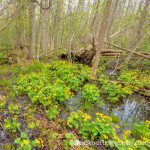 Belanger Creek— This ecological powerhouse near Suttons Bay features 2, 800 feet of stream corridor. A floristic survey conducted here documented an astounding 170 species, including 30 wildflowers. Come spring, the steep hillsides and are full of trillium while sunny marsh marigolds line over a half-mile of protected stream frontage. Six seeps and 11 springs feed into Belanger Creek, and the surrounding 5,600 acres all drain into the stream.
Belanger Creek— This ecological powerhouse near Suttons Bay features 2, 800 feet of stream corridor. A floristic survey conducted here documented an astounding 170 species, including 30 wildflowers. Come spring, the steep hillsides and are full of trillium while sunny marsh marigolds line over a half-mile of protected stream frontage. Six seeps and 11 springs feed into Belanger Creek, and the surrounding 5,600 acres all drain into the stream.
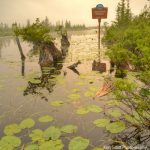 Cedar River—Located in the Solon Swamp, near the southwest corner of South Lake Leelanau, this area has sustained no observable human impact, except for some cedars that were cut over 100 years ago. In addition to Cedar River’s impressive floristic quality mentioned earlier in this article, the Cedar River is a beautiful, quiet place to kayak or canoe and to enjoy nature at its most diverse. The entire waterway from the mouth of Lake Leelanau to the village of Cedar is protected and open to the public. A paddle through it is the perfect place to view stunning yellow pond lilies, see a mink slip into the water or watch an osprey dive for its dinner.
Cedar River—Located in the Solon Swamp, near the southwest corner of South Lake Leelanau, this area has sustained no observable human impact, except for some cedars that were cut over 100 years ago. In addition to Cedar River’s impressive floristic quality mentioned earlier in this article, the Cedar River is a beautiful, quiet place to kayak or canoe and to enjoy nature at its most diverse. The entire waterway from the mouth of Lake Leelanau to the village of Cedar is protected and open to the public. A paddle through it is the perfect place to view stunning yellow pond lilies, see a mink slip into the water or watch an osprey dive for its dinner.
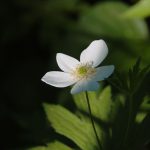 Frazier-Freeland— The 13-acre Frazier-Freeland Preserve protects the wetlands and water of Weaver Creek, an important stream that flows into Grand Traverse Bay near Omena. Wildlife and numerous bird species make their homes in this Preserve. The dense thicket, where deer and other critters roam, is rich with food and shelter for wildlife.
Frazier-Freeland— The 13-acre Frazier-Freeland Preserve protects the wetlands and water of Weaver Creek, an important stream that flows into Grand Traverse Bay near Omena. Wildlife and numerous bird species make their homes in this Preserve. The dense thicket, where deer and other critters roam, is rich with food and shelter for wildlife.
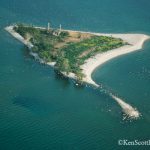 Gull Island–Sitting just off the coast in Northport Bay, the island is preserved as a sanctuary for thousands of herring gulls, whose populations have declined in the last 25 years. Don’t confuse these birds with ubiquitous “sea gulls” which herring gulls help to keep in check. The birds, which mate for life, will abandon their nests at the slightest disturbance. In a long-term study here, banded birds have returned for as many as 24 years. A crumbling stone cottage on the island was once inhabited and is a unique part of Northport’s history.
Gull Island–Sitting just off the coast in Northport Bay, the island is preserved as a sanctuary for thousands of herring gulls, whose populations have declined in the last 25 years. Don’t confuse these birds with ubiquitous “sea gulls” which herring gulls help to keep in check. The birds, which mate for life, will abandon their nests at the slightest disturbance. In a long-term study here, banded birds have returned for as many as 24 years. A crumbling stone cottage on the island was once inhabited and is a unique part of Northport’s history.
 Hatlem Creek–The creek and the sensitive wetlands surrounding it provide an important source of fresh water to Glen Lake and the Preserve shelters over ½ mile of stream frontage. The federally endangered Michigan Monkey Flower grows in the area, thriving in wet, mucky soils where cool waters flow. Hatlem Creek is also a wildlife haven; red-shouldered hawk nest in the closed forest canopy and trout and salmon spawn in the stream. A rare bubbling marl spring, 100 square feet in size, is a must-see natural feature.
Hatlem Creek–The creek and the sensitive wetlands surrounding it provide an important source of fresh water to Glen Lake and the Preserve shelters over ½ mile of stream frontage. The federally endangered Michigan Monkey Flower grows in the area, thriving in wet, mucky soils where cool waters flow. Hatlem Creek is also a wildlife haven; red-shouldered hawk nest in the closed forest canopy and trout and salmon spawn in the stream. A rare bubbling marl spring, 100 square feet in size, is a must-see natural feature.
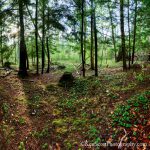 Jeff Lamont–This forested wetland at the tip of the peninsula features a magical trail through maple, hemlock and beech, dotted with pink lady slippers and other wildflowers come spring. A dense wetland thicket with ferns and 6-foot-tall cattails provides important wildlife habitat. Canopy birds such as the scarlet tanager sing from the treetops. The preserve is part of a crucial wildlife corridor.
Jeff Lamont–This forested wetland at the tip of the peninsula features a magical trail through maple, hemlock and beech, dotted with pink lady slippers and other wildflowers come spring. A dense wetland thicket with ferns and 6-foot-tall cattails provides important wildlife habitat. Canopy birds such as the scarlet tanager sing from the treetops. The preserve is part of a crucial wildlife corridor.
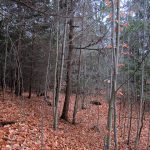 Mebert Creek-Greeno–A tapestry of wetland habitat provides an undisturbed haven for rare and threatened plants where Mebert Creek flows into Lake Leelanau. One of the region’s most diverse wetland complexes, with over a mile of shoreline, this area filters excess nutrients and protects water quality.
Mebert Creek-Greeno–A tapestry of wetland habitat provides an undisturbed haven for rare and threatened plants where Mebert Creek flows into Lake Leelanau. One of the region’s most diverse wetland complexes, with over a mile of shoreline, this area filters excess nutrients and protects water quality.
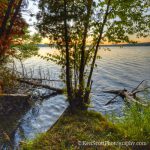 Swanson–The Conservancy had two goals when it purchased the Swanson Preserve along M-22 near Sugarloaf. First, to protect 2,000 feet of shoreline on Little Traverse Lake and its two distinct wetland communities critical to wildlife and the health of the lake. Second: to revitalize the adjacent 13-acre iconic farmstead, known as “Sonny’s Farm”–home to a beloved farm stand. (That land has since been sold to a young farmer.) Swanson Preserve is one of our most ecologically diverse, with 207 documented plant species. Among them: the rare Berulaerecta (cut-leaved water parsnip.)
Swanson–The Conservancy had two goals when it purchased the Swanson Preserve along M-22 near Sugarloaf. First, to protect 2,000 feet of shoreline on Little Traverse Lake and its two distinct wetland communities critical to wildlife and the health of the lake. Second: to revitalize the adjacent 13-acre iconic farmstead, known as “Sonny’s Farm”–home to a beloved farm stand. (That land has since been sold to a young farmer.) Swanson Preserve is one of our most ecologically diverse, with 207 documented plant species. Among them: the rare Berulaerecta (cut-leaved water parsnip.)
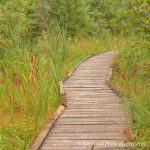 Teichner—This Preserve features 200 feet of natural shoreline on Lime Lake, framed by mature cedars. A boardwalk traverses the fragile forested wetland and offers views of a vibrant and healthy ecosystem. Come spring, the sounds of birds, frogs and trees creaking in the wind fill the air, while wildflowers put on a spectacular show from the boardwalk. On a part of the Preserve, a road was put in at one point for a housing development that never came to pass. The road has since been removed and the wetlands reconnected and restored.
Teichner—This Preserve features 200 feet of natural shoreline on Lime Lake, framed by mature cedars. A boardwalk traverses the fragile forested wetland and offers views of a vibrant and healthy ecosystem. Come spring, the sounds of birds, frogs and trees creaking in the wind fill the air, while wildflowers put on a spectacular show from the boardwalk. On a part of the Preserve, a road was put in at one point for a housing development that never came to pass. The road has since been removed and the wetlands reconnected and restored.
Special thanks to Sharon Oriel, Board President and Docent, who wrote much of this article.



